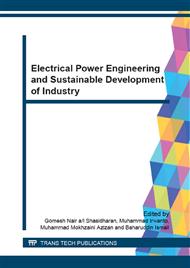[1]
A. Moussa, M. el-Gammal, E. Abdallah, and A. El-SLoud, Hardware-software structure for on-line power quality assessment, in proceedings of the 2004 ASME/IEEE Joint, pp.147-152, (2004).
DOI: 10.1115/rtd2004-66022
Google Scholar
[2]
M. A. M. Balded, S. M. S. Ahmad, A. Shakil, ANOVA- Based feature analysis and selection in HMM-Based offline signature verification sysytem, IEEE Conf. on Innovative Technologies in Intelligent Sysytems and Industrial Applications, pp.66-69, (2009).
DOI: 10.1109/citisia.2009.5224240
Google Scholar
[3]
L. Mansinha, R.G. Stockwell, R.P. lowe, M. Eramian, and R.A. Schincariol, Local s-spectrum anaysis of 1-D and 2-D data, Physics of the Earth and Planetary Interiors, vol. 103, pp.329-336, (1997).
DOI: 10.1016/s0031-9201(97)00047-2
Google Scholar
[4]
M. V. Chilukuri and P. K. Dash, Multiresolution S-transform-based fuzzy recognition system for power quality events, IEEE Trans. Power Del., vol. 19(1), pp.323-330, (2004).
DOI: 10.1109/tpwrd.2003.820180
Google Scholar
[5]
S. Kaerwarsa, Classification of power quality disturbances using s-transform based arificial neural networks, IEEE International Conf. of Intelligent Computing and Intelligent systems, pp.566-570, (2009).
DOI: 10.1109/icicisys.2009.5357780
Google Scholar
[6]
P.K. Dash, B.K. Panigrahi, and G. Panda, Power quality analysis using S-transform, IEEE Trans. On Power Delivery, vol. 18(2), pp.406-411, (2003).
DOI: 10.1109/tpwrd.2003.809616
Google Scholar
[7]
R.G. Stockwell, L. Mansinha, and R.P. Lowe, Localization of the complex spectrum: The S-transform, IEEE Trans. Signal Processing vol. 44, no. 4, pp.998-1001, (1996).
DOI: 10.1109/78.492555
Google Scholar
[8]
S. Mishra, C.N. Bhende, and B.K. Panigrahi, Detection and classification of power quality disturbance using s-transform and probabilistics neural network, IEEE Trans. Power Delivery, vol. 23, no. 1, pp.280-287, (2008).
DOI: 10.1109/tpwrd.2007.911125
Google Scholar
[9]
A. E. Permanasari, D. R. A. Rambli, P. D. D. Dominic, Forecasting method using ANOVA and Duncan multiple range tests on time series dataset, Conf. Proceedings of the International Symposium in Infrmation technology (ITSIM), (Vol. 2) IEEE Xplore, pp.941-945, (2010).
DOI: 10.1109/itsim.2010.5561535
Google Scholar
[10]
M. Nayak, B.S. Panigrahi, Advanced signal processing technique for feature extraction in data mining, International Journal of Computer applications, vol. 19, no. 9, pp.30-37, (2011).
DOI: 10.5120/2387-3160
Google Scholar
[13]
StatSoft. (2008). ANOVA/MANOVA [Online]. Available: http: /www. Statsoft. com/textbook/Stanman. html.
Google Scholar
[14]
K. Daud, A. F. Abidin, N. Hamzah, and H. S. N. Singh, New windowing technique detection of sags and swells based on continuous s-transform (CST), International Journal of New Computer Architectures and their Applications (IJNCAA), 2(4), pp.550-555, (2012).
Google Scholar
[15]
K. Daud, A. F. Abidin, N. Hamzah, and H. S. N. Singh, Detection of sags, swells, and transients using windowing technique based on continuous s-transform (CST), International Journal of Electrical, Electronic Science and Engineering, World Acedemy of Science Engineering and Technology (WASET), Vol: 7 No: 5, pp.156-163, (2013).
Google Scholar
[18]
Z. A. Bakar, D. I. Ispawi, N. F. Ibrahim, N. M. Tahir, Classification of parkinson's disease based on multilayer perceptrons (MLPs) neural network and ANOVA as a feature extraction, in proceedings of International Colloqium on Signal Processing and its Application, IEEE, pp.63-67, (2012).
DOI: 10.1109/cspa.2012.6194692
Google Scholar
[19]
Shuang-Huan Zhan, Hong-Bin Zhang, Blind steganalysis using wavelet statistics and ANOVA, in Proceedings of the 6th International Conference on Machine Learning and Cybernetics, IEEE, pp.2515-2519, (2007).
DOI: 10.1109/icmlc.2007.4370570
Google Scholar


